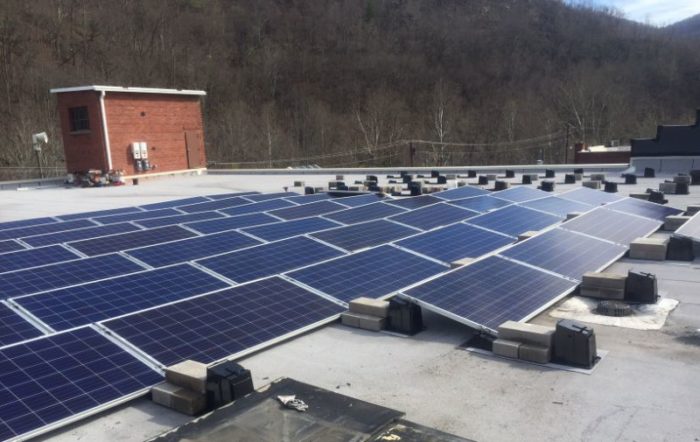Image Credit: Bluegrass Solar
Image Credit: Bluegrass Solar The coal museum is in a former commissary for International Harvester.
The exhibits inside are all about the glory days of coal, but it will be the solar panels on the roof that knock as much as $10,000 off the power bills for the Kentucky Coal Mining Museum.
Housed in a former International Harvester commissary, the museum features exhibits detailing the history of coal mining in the city of Benham and surrounding parts of Harlan County, a bastion of mining in eastern Kentucky. The museum, which opened in 1994, is owned by Southeast Kentucky Community and Technical College.
The 60 kW solar array now being installed on the museum’s roof by Bluegrass Solar is part of a 250 kW system that will serve Benham’s municipal power grid. Bluegrass owner Tre Sexton said the project is being underwritten by “assorted philanthropic sources.” The 80-panel array is roughly half complete, Sexton told GBA, and could be wrapped up in another week or so.
At a time when renewable energy advocates are squaring off against a president who has pledged to “put our miners back to work,” seeing solar come to the rescue of a coal museum is rich with irony. But money is money, and the college estimates energy bills now average about $2,100 a month, according to USA Today.
Sexton told GBA that the project may have raised a few eyebrows in town, but has generally been accepted by city residents.
“Everybody sort of smiles and has a little laugh about it,” he told GBA. “But we’ve not been greeted with any animosity or anything. They just get a chuckle out of it. It’s a pretty good headline.”
Even though the region has a long history of coal mining, the industry is not as powerful as it once was, Sexton said.
“We’re just now kind of getting over that grief and starting to let go,” he said. “It’s certainly still in the roots and everything.”
Even in its heyday, he added, coal mined in the area was mostly used in steel production, not coal-burning power plants. “We’re pretty big on metallurgical coal,” he said. “We weren’t really an energy producer anyway.”
Residential solar slow to catch on
Bluegrass Solar is about eight months old, and if the city of Benham has embraced solar energy with its planned municipal system, Sexton is still trying to get his residential business up to its full potential.
“We started trying to focus on residential,” he said, “and we’ve had a lot of interest but not a lot of execution.”
Bluegrass joined forces with a partner, Star Solar, and began offering leases and financing and now the company’s focus is on municipal installations. Its alliance with Star Solar has allowed the company to begin offering leasing, financing, and partnership agreements.
“That should make it easier for homeowners to get on board,” he said.
Weekly Newsletter
Get building science and energy efficiency advice, plus special offers, in your inbox.
















0 Comments
Log in or create an account to post a comment.
Sign up Log in